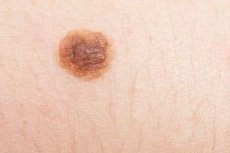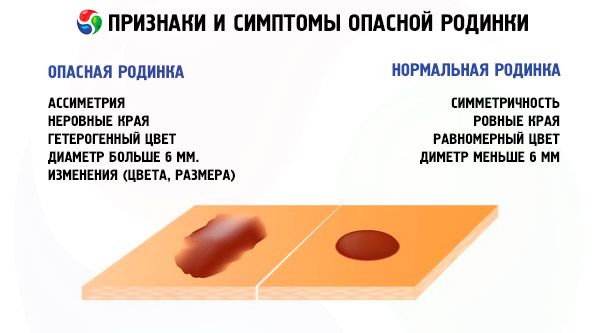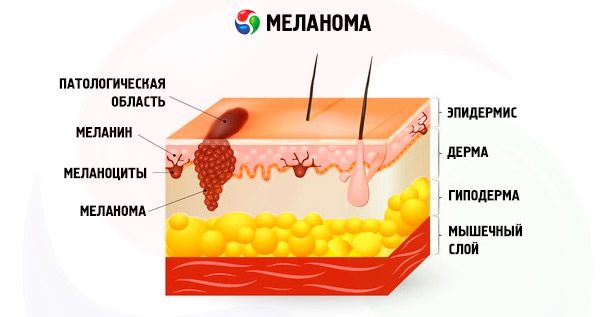Medical expert of the article
New publications
A rough mole
Last reviewed: 04.07.2025

All iLive content is medically reviewed or fact checked to ensure as much factual accuracy as possible.
We have strict sourcing guidelines and only link to reputable media sites, academic research institutions and, whenever possible, medically peer reviewed studies. Note that the numbers in parentheses ([1], [2], etc.) are clickable links to these studies.
If you feel that any of our content is inaccurate, out-of-date, or otherwise questionable, please select it and press Ctrl + Enter.

Moles can be found on any person's body. Some moles begin to change over time. And this often leads to an increased risk of developing a tumor. If you notice that a rough mole has appeared on your body, this most likely indicates the degeneration of a nevus. It is very important that a dermatologist monitors this process. A rough mole can itch during degeneration. Especially often, unpleasant sensations appear due to a lack of vitamins, but we must not forget about the high risk of degeneration of a nevus into skin cancer.
 [ 1 ]
[ 1 ]
Causes rough mole
Moles or nevi are not considered malignant tumors in themselves. They can degenerate into cancer cells due to various reasons.
Immediately after birth, there is not a single mole on the child's body. Pigment spots and nevi begin to appear only in the first year of life and continue to do so from time to time until death. Often, moles begin to degenerate, become rough and uneven. Doctors call them keratomas.
As a rule, the appearance of a rough mole (keratoma) is a reaction of the skin to ultraviolet radiation. The normal process of keratinization is disrupted. Risk factors for the appearance of a rough mole also include: poor nutrition, metabolic disorders, lack of vitamins and minerals, hormonal imbalance.
Very often, a rough mole appears in a place that has been exposed to friction, chemicals or ultraviolet radiation for a long time.
 [ 2 ]
[ 2 ]
Pathogenesis
The main factor that determines the development and occurrence of a rough mole is the amount of ultraviolet radiation that the body receives throughout its life. Heredity also plays an important role.
Rough moles can be flat or slightly raised above the skin. Sometimes they appear in the first year of life, but more often they develop in place of congenital nevi over time. As a rule, the appearance of new spots occurs before the age of 30. If after 35 years of age, new growths in the form of rough moles begin to appear on your body, you should immediately consult a dermatologist.
Symptoms rough mole
Of course, almost every person has moles on their body. Not all of them are malignant, so they do not always need to be removed. There are cases when a congenital nevus begins to change quickly in appearance without any reason. The mole becomes rough to the touch, begins to peel and itch a lot. Of course, a rough mole can be a consequence of vitamin deficiency and poor nutrition. It is important to remember that a healthy mole should be smooth and soft to the touch, without any compactions.
What should you pay special attention to if a mole becomes rough to the touch?
- Suppuration appears inside the nevus and blood flows from it.
- The mole often itches, and a tingling or burning sensation appears.
- A lump appeared in its center.
- When you touch the spot, you feel pain.
- The mole becomes bumpy and rough.
- In a short time it grows rapidly.

Round rough mole
Birthmarks that are small in size, have a smooth surface and do not bother a person with itching or pain are considered safe. A round, rough birthmark is also not dangerous if its size does not exceed 5 mm and it does not protrude much above the surface of the skin.
Particular attention should be paid to round nevi that were smooth but suddenly began to peel and itch. Dermatologists also recommend undergoing diagnostics for round rough moles with a large diameter. They usually appear in adulthood and often change their size and color.
Rough birthmark on a child
Children always have fewer nevi than adults. They are usually no different from regular birthmarks. They are light or dark brown, smooth to the touch, and sometimes slightly raised above the skin.
The appearance of new pigment spots in children should not always cause concern. In what cases should you immediately make an appointment with a dermatologist?
- Nevi, which are distinguished by their rather large size.
- The surface of the mole is rough and the skin around it is too dry.
- The child accidentally tore or scratched a rough mole.
Complications and consequences
Diagnostics rough mole
After you seek help at a clinic, the dermatologist will first conduct a thorough diagnosis of the rough mole. It is very important to examine not only the nevus for which you came to the doctor, but also all birthmarks, even if they look quite harmless.
Don't worry right away. In most cases, peeling and itching in a mole does not indicate its degeneration into skin cancer. But, according to statistics, in 4-5% of cases, these symptoms lead to the development of melanoma.
What methods of diagnosing skin tumors does modern oncology offer?
First of all, the doctor examines the rough mole. Visually, a professional specialist can see many different features of the nevus structure to determine whether further diagnostics are necessary. Then comes the turn of histological examinations. If there is a suspicion that the birthmark is degenerating or has already degenerated into melanoma, histology is mandatory after the neoplasm is removed. Histological examination gives a 100% accurate result.
Tests
As a rule, a mole analysis, i.e. a histological examination for the presence of malignant cells in it, is carried out after the nevus has been removed. During the operation, the doctor takes a small part of the rough mole and sends it to the laboratory. Histology is a morphological analysis of the nevus tissues, which is carried out using a special microscope. In some cases, histological analysis is carried out before surgery.
Recently, digital analysis of nevi has become very popular. To perform it, doctors use the German system "Fotofinder". With its help, you can record all the available characteristics of a rough mole, constantly monitor its development in dynamics. Thus, you can control the growth of a nevus for a long time.
Molecular diagnostics is a diagnostic method that allows a doctor to detect a single cell affected by melanoma among a million healthy ones.
Instrumental diagnostics
Today, there are many instrumental diagnostic methods that allow one to notice in time the degeneration of a congenital nevus into a malignant neoplasm.
The most popular of these is dermatoscopy. The doctor examines all neoplasms on the patient's skin using a special device (dermatoscope). Thanks to this diagnostic method, the dermatologist can "look" inside a rough mole without additional tests. It allows you to determine the type of nevus, look at its structure and determine whether it is a benign formation.
Another modern method is computer epiluminescent dermatoscopy (CED). It can be used to monitor degenerating moles. Thanks to the new technology, a dermatologist can not only examine all the details of the nevus surface, but also the changes that occur inside it. The main advantage of this method is the fact that the tissue of the rough mole is not injured at all.
Confocal microscopy is not a very popular diagnostic method, but despite this, it is sometimes used when examining rough moles. It allows you to study the skin at the cellular level. A special microscope with infrared radiation is used for this.
Radioisotope skin scanning – during the diagnostic process using this method, the doctor takes pictures of all the changes that have occurred inside the mole.
What do need to examine?
How to examine?
Differential diagnosis
When diagnosing a rough mole, it is very important to exclude the possibility of developing some other similar neoplasms: Bowen's disease, xeroderma pigmentosum, senile keratosis, melanoma and basalioma.
Who to contact?
Treatment rough mole
If you have a rough mole, do not worry prematurely. The development of such a nevus does not always mean that the birthmark has become melanoma. Of course, you should immediately make an appointment with a doctor, even if the rough mole does not bother you in any way. Only a thorough and professional diagnosis will help completely exclude the possibility of a malignant tumor.
Removal of a rough mole
There are several ways to remove a rough mole:
- Cryodestruction – helps to get rid of a rough mole using liquid nitrogen. The cold affects the cells of the nevus, destroying them. In the process of such removal, a very low temperature is used.
- Electrocoagulation – current is used to remove skin growths. The procedure usually takes from 5 to 20 minutes (depending on the size of the mole) and does not leave scars on the skin.
- Laser surgery – allows for minimal damage to the skin and complete removal of the nevus in a short time.
- Sclerotherapy.
- Radio wave surgery using the Surgitron device.
If a rough mole appeared due to the degeneration of a congenital birthmark into melanoma, surgical intervention is the only correct method of treatment.
Medicines
The most effective medicine for treating a rough mole is the ointment "Stefalin". It is based on plant components, without any chemical additives. Thanks to this remedy, you can painlessly and easily get rid of benign neoplasms. It does not leave scars on the skin, acting gently on the skin. The main advantage is that the ointment can be used at home.
Before using medications and folk methods of treating a rough mole, you should definitely consult a dermatologist!
Traditional and herbal medicine
- Lemon and garlic juice – to treat a rough mole, you need to lubricate it every day first with the juice of one clove of garlic, and then (after 2-3 seconds) with lemon juice. Remember that the procedure must be repeated throughout the day.
- If the rough mole is large, you first need to thoroughly cleanse the body of toxins using a special rice diet. But it is worth remembering that this method takes at least 45 days.
Prevention
It is quite difficult to single out any specific types of prevention of rough moles. But you can eliminate the factors that influence their development:
- Protect your skin (especially areas where new moles have appeared) from ultraviolet radiation.
- Try to avoid skin contact with various chemicals.
- Avoid taking any food additives that increase your risk of developing cancer.
- Watch closely for new growths on your skin.
- Get examined by a dermatologist annually.
- Try not to injure the new growths.
Forecast
The appearance of a rough mole does not always indicate the development of skin cancer. But they should not be ignored by a dermatologist. By conducting a timely consultation, you will be able to completely dispel your doubts and begin the correct treatment. Remember that in the early stages of melanoma, the prognosis is favorable.
 [ 18 ]
[ 18 ]


